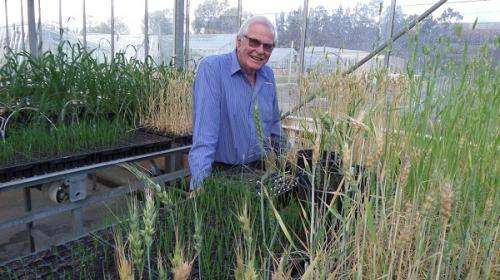Lower chlorophyll to boost wheat yields

Almost five decades ago, a plant breeder proved that the tiny brassica Arabidopsis thaliana has higher overall leaf growth when it produces less chlorophyll.
Now, UWA Adjunct Professor John Hamblin is repeating his experiments with wheat to see if lower chlorophyll levels promote greater grain yields.
He offers four possible reasons why low-chlorophyll wheat might be more productive.
Firstly, leaves naturally produce shade, depriving competing plants of light.
This is a useful adaptation in nature but a disadvantage in crops, where growers want minimal competition between neighbours.
Secondly, harvesting excessive light damages chloroplasts, the tiny organelles that contain chlorophyll and produce energy. Repairing damaged chloroplasts uses extra energy.
Thirdly, capturing excess light causes the plant to heat up, like a black car which absorbs more heat and heats up faster than a white car which reflects it.
"If you heat up a leaf, so for it to survive it has to use more water," he says.
"It has to cool itself like an evaporative air conditioner.
"The fourth reason is that chloroplasts are full of all sorts of goodies.
"If you are not using them to fix light you can use them for other jobs round the farm like bigger roots or bigger heads."
Hybrid wheat varietals
He has prepared for trials by breeding from two parent varieties.
The first is Transfer, a wheat variety first produced in the 1950s which has very low chlorophyll.
He also obtained another new variety from agricultural scientist Dr David Bowran.
"He had a wheat which was very upright and very stiff—it produced very big ears but not many."
He has arranged for the company Intergrain to hybridise these to produce new parent varieties.
"There are two technologies which can produce your true breeding plants very quickly," he says.
With the first, double-haploids, they are able to breed a true breeding strain using only the genes contained in a pollen.
"They get it to produce two sets of genes but because there was only one there to start with they're absolutely identical," he says.
They are also using the newly-developed recombinant inbred lines technology, which can produce up to eight generations of wheat a year.
"The ninth generation is almost exactly the same as the eighth generation," Prof Hamblin says.
He expects to have true breeding lines next season, which he will select for high and low chlorophyll varieties to begin his trial the following year.
Notes:
Prof Hamblin is based at the University of Western Australia's Institute of Agriculture.
His recent collaborative paper Variation in Chlorophyll Content per Unit Leaf Area in Spring Wheat and Implications for Selection in Segregating Material has been published in PLoS ONE.
More information: Hamblin J, Stefanova K, Angessa TT (2014) "Variation in Chlorophyll Content per Unit Leaf Area in Spring Wheat and Implications for Selection in Segregating Material." PLoS ONE 9(3): e92529. DOI: 10.1371/journal.pone.0092529
Journal information: PLoS ONE
Provided by Science Network WA





















